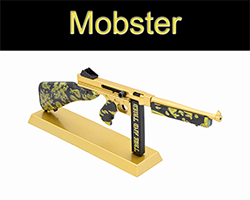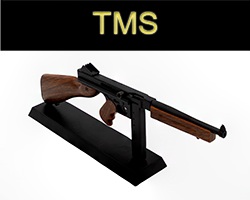Thompson Submachine Gun
History of the TSMG
Designed for clearing the narrow passageways of the World War I trenches, the world was given the Thompson Submachine Gun. Brigadier General John T Thompson tasked the firearm company he owned, the Auto-Ordnance Corporation, with designing this firearm. Before they settled on calling it the Thompson Submachine Gun, the firearm went by the name The Annihilator for the magazine fed version, or The Persuader for a belt fed design. Over the years, this iconic little firearm picked up some unofficial names as well like The Trench Broom, The Chopper, and the Chicago Organ Grinder. The design of the Thompson was completed with prototypes ready for war, but on November 11th, 1918, the Armistice was signed between the Allied and German forces ending the conflict before the SMG had a chance to show what it was capable of.
In 1919 the first version, known at the Annihilator I, went into full production it did not have selective fire, only fully automatic fire capable of dumping fifteen-hundred rounds per minute, or at least it could if the magazine could hold that many. That rate of fire turned out to be a bit much. Who would have guessed? This gave way to the Annihilator II, featuring fins on the barrel to help prevent overheating, a sliding breach block to allow the selection of semiautomatic fire, a blade style front sight, a removable foregrip and slots to accommodate a box magazine. They also adjusted the angle of the breach block reducing the fire rate down to a more manageable eight hundred rounds per minute.
In 1921 Thompson contracted colt to produce 15,000 firearms that he tried to sell over in Europe but had better luck selling them to the US postal service. I know picture your mailman going door to door with a submachine gun slung over his shoulder. Really though they were used to guard mail trains since at the time there had been a lot of violent train robberies. They also went to the Marine Corps and Navy as well as sale on the commercial market to ranchers, law enforcement and the Mob.
During World War II a lack of firearms to kit out the infantry men lead to the US army contracting the Auto-Ordnance Corp. for 20,405 Thompsons designated M1921A1. The firearm was revised in 1928 when production was taken over by Federal Laboratories, making it more resilient to the soldiers using it. It was dubbed the 1928A1 model and it also had a slightly slower fire rate at 725 RPM. In 1938 the Thompson was adopted by the US military. Looking to simplify the firearm, a prototype for the M1A1 came out in 1942 now with an even slower rate of fire at only 600 RPM. By 1942 half a million had been made and the “Tommy Gun” was the most famous submachine gun of the war.
The Thompson was used in World War II, the Vietnam War, and the Korean War, but it was the high cost of production that led to its downfall. In 1942 the US army introduced the M3 Grease Gun. The Thompson had many machined parts while the Grease Gun was made from stamped metal using rivets and welds to put it together it was a far cheaper model. With 1,387,134 made, its manufacturing stopped in 1944.
GoatGuns Models




